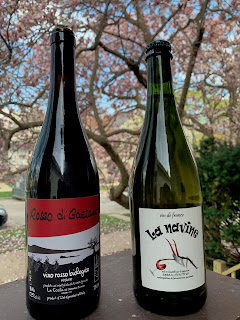In the German language there are two words synonymous with our English word “experience”. There is Erlebnis referring to a physical sensation, something that is happening to you and Erfahrung which serves as your understanding of your past and the perception which shapes your present. I read about this in an art history book and am not a student of this language so I don’t know what the Germans have to say about the word “taste”. There are a few definitions of that word in English too that I think nestle nicely into the German understanding of experience. The immediacy of perceiving a flavor through your mouth, nose, and brain feels more Erlebnis to me and whether or not we appreciate it in the catalog of things that we like feels more Erfahrung. I like this because in the moment of tasting (taking a small amount of food or drink to your mouth, yet another definition of taste) the distinctions become less clear and it almost feels appropriate that we have one word for this whole thing.
In hospitality it’s your job to usher someone through processing of what you’ve sold them, it’s fun and feels valuable to both parties though I’m too confused at present to tell you why this actually is. When I managed a restaurant I wrote a little document to help facilitate discussions about the dishes we would taste. It was one of those restaurants where the food changed a lot and we were often trying something that was unfinished and rushing to dot the i’s and cross the t’s before service. This was written in 2017 and I think I would add some things now, mostly about learning the history of cookery and where dishes come from. This is probably why I wrote that dry piece about dry bread, which is good by the way and I still think you should make it. However, I will offer this older idea unchanged because, whatever, it seems easier to approach like this. While it was written for food it could be for wine too, kind of:
How to Taste Food
Textures: one? multiple how do they interact? are they layered and fused? or experienced in sequence?
Temperature: same questions
Flavors: what do you taste and how do the texture and temperature affect your perception of flavor?
Emotional Stuff:
-does it remind you of food that you know in other contexts?
-does it satisfy a craving you had or didn’t know you had (like thinking about the weather and stuff)? did you experience something new? if so, where did that newness come from? what does that inspire (if anything)? imagined worlds, future culture, etc.
-basically what kind of person does the food make you see yourself as? is there a moment that makes your heart jump and what contributed to it?
maybe: does it leave you wanting something? if so can you identify it?
These questions got people talking in a way where they could connect the taste they were experiencing to their past and build on their spectrum of things to pull from. New people were always quiet, it takes a lot of confidence to speak in this gray area that is neither wholly objective or subjective. The more we talked together though the more fluid conversation became and the less we had to refer to conversation starters. It felt like we could help each other pull those words out of our bodies. Some days you would find something you didn’t know was there or hadn’t already registered as pleasurable. Other days you realize you just don’t have the capacity to understand something presently. And then there’s another kind of day when you encounter something familiar and beloved and you’re not challenged at all and it’s quite comforting.
Thank you to everyone that’s shared beautiful tasting notes and drawings. I appreciate your vulnerability and I learn so much from you. If anyone ever wants someone to talk to about something they are tasting, food or wine DM @rainbow_wines we’ll work it out together. You can place an order in the shop Thursdays, Fridays, and Saturdays before 5 and expect your wine the same day.
-Emily









